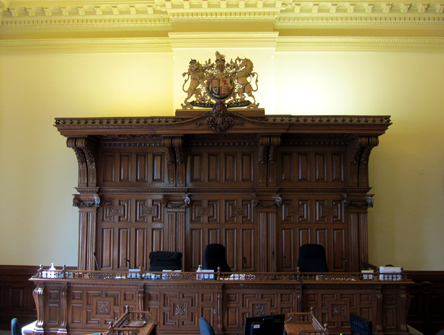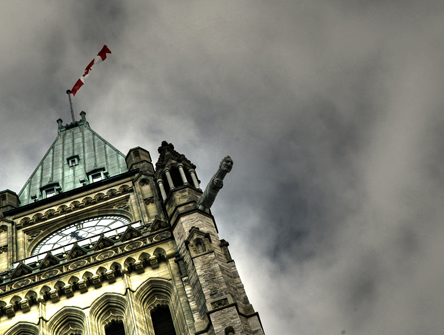The Supreme Court and the legacy of the Quebec Secession Reference
From time to time the Supreme Court is called upon to answer the big, existential questions about Canada.

From time to time the Supreme Court is called upon to answer the big, existential questions about Canada. So it is noteworthy that the newest appointment to the court, Justice Russell Brown, once wrote—when he was a University of Alberta law professor—that a province’s secession was not a matter for the court to decide.
The comment was published in a blog post about the Supreme Court’s groundbreaking opinion in the Reference re Secession of Quebec, handed down a few years after the razor-thin referendum result in 1995, and which established the “clear majority on a clear question” principle: If a clear majority of Quebecers voted to secede, that would trigger a constitutional obligation on the rest of the federation to negotiate the terms of that secession. Here’s what Professor Brown wrote in 2007:
Parliament conferred upon the Court powers to interpret the rules of the game, not to determine how and when someone can quit the game. If there ever was a question for legislatures and parliaments to sort out for themselves, subscription to and disassociation from a federal structure is surely it, no?
Respectfully, my own view is that the Supreme Court was right to tackle this question, and has the competence and legitimacy to answer similar questions in future. This part of the court’s role is all the more important given that in 2015 and onward, many of the existential questions facing Canada will inevitably relate to the urgent issue of reconciliation of Aboriginal and non-Aboriginal communities in Canada. These are likely to end up on the Supreme Court Justices’ desks.
But back to 1998 for a moment.
Recall that the amicus curiae in the Reference raised the preliminary objection that the reference questions were not justiciable, in part because they were “political.” The court quite properly rejected this submission.
One of the many ways the Secession Reference fascinates is that it gave the court an opportunity to turn a mirror onto itself, and consider where it fits in the Canadian constitutional structure. As the court repeated throughout the Reference, its role includes providing and clarifying the “legal framework” for political decision-making, including decision-making by political actors about Quebec secession. The “political” aspect of a question does not automatically take it out of the court’s jurisdiction.
The question of whether a province could leave the federation—“quit the game,” as Justice Brown put it—then led the court to take a passionate but pragmatic look at Canada’s makeup. Like a game of constitutional Jenga, would Canada still be Canada without Quebec?
The court answered this question by resorting to “four fundamental and organizing principles of the Constitution”: “federalism; democracy; constitutionalism and the rule of law; and respect for minorities.”
The adaptability of these principles makes the Secession Reference an instructive precedent for other fundamental questions about our constitutional order that could come before the Supreme Court. In the near future, the most pressing of these questions will relate to righting the wrongs committed against Canada’s Aboriginal peoples, and reconciling Aboriginal interests with the Crown and other Canadian communities.
Consider the calls to action set out in the initial Truth and Reconciliation Commission report, in response to the history of residential schools in Canada. Even though these recommendations are directed to the federal, provincial, or territorial governments—and, therefore, “political”—the Supreme Court could very well be asked to pronounce upon the appropriate legal framework for their implementation.
If it is, it will surely return to the Secession Reference. But when it does, it will find that certain constitutional preconceptions abound in the Reference, which are inconsistent with the TRC’s calls to action – not least of which is the assumption that Canada is a two-level federation governed by federal and provincial governments, leaving little to no room for Aboriginal self-government and standing in stark contrast to the “nation-to-nation relationship” between Aboriginal peoples and the Crown assumed in the TRC. Two of the TRC’s calls to action in particular—the “recognition and implementation of Aboriginal justice systems”; the other for a new “Royal Proclamation” that will “reaffirm the nation-to-nation relationship between Aboriginal peoples and the Crown”—challenge the established constitutional order as expressed in the Secession Reference.
(It must be acknowledged that the Supreme Court is not necessarily the best place to resolve issues related to implementing the TRC recommendations, some of which focus on establishing Indigenous legal systems, but it is one logical place within the current common-law paradigm where that might happen.)
This is not to say that Indigenous interests are completely ignored in the Secession Reference; they are not. Several Aboriginal groups acted as intervenors on the Reference, and the Court made specific mention of section 35 in its discussion of the “protection of minorities” principle (see paras 81-82). But, for the most part, Aboriginal peoples’ concerns were understood in reaction to what might happen with Quebec. The Court even said it entrusted that any political negotiations on secession would ensure “aboriginal interests would be taken into account” so it was “unnecessary to explore further the concerns of the aboriginal peoples in this Reference.”
But we know from the Court’s opinion in the Reference that “[t]he Constitution is not a straitjacket.” The four organizing principles can evolve, “living tree”-style, to accommodate the TRC’s refreshed conception of our constitutional order, even though it differs greatly from the vision expressed in the Secession Reference.
The Court has hinted at this evolution, in Tsilhqot’in Nation v British Columbia. Surely, a post-Tsilhqot’in Court would pay more than lip service to Aboriginal interests in any future case about adjustments to Canada’s constitutional architecture – especially a case about the implementation of the TRC recommendations. The Secession Reference showed that Canada’s constitutional framework is flexible enough to challenge preconceived notions about how our governing and judicial bodies should look, so it is flexible enough to accommodate Aboriginal communities as equal partners in the framework.
To sum up, the Secession Reference “required [the Court] to consider momentous questions that go to the heart of our system of constitutional government.” It is part of the legacy of the Supreme Court to which Justice Brown will soon belong. Whether he will adopt the constitutional views expressed in the Reference is another matter, but what should be clear is the court’s vital role in answering Canada’s existential questions.


